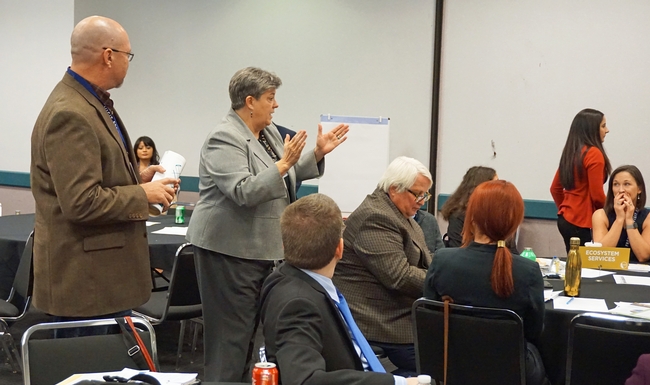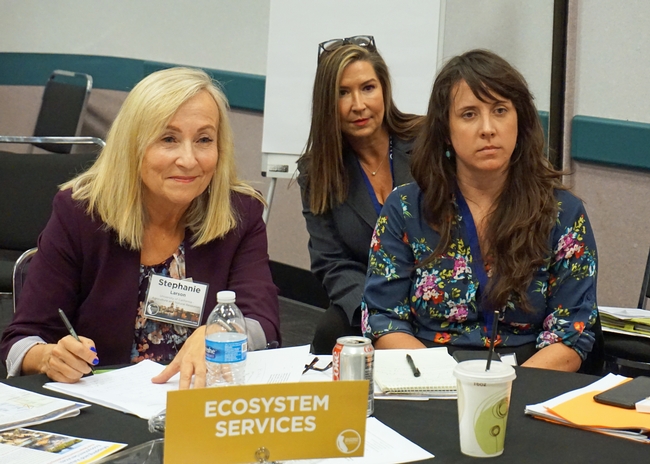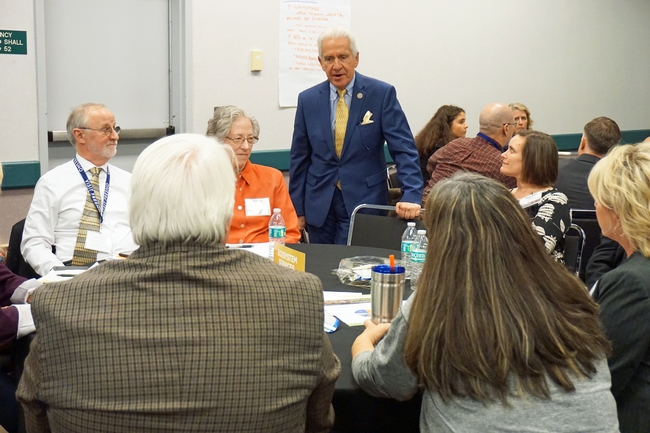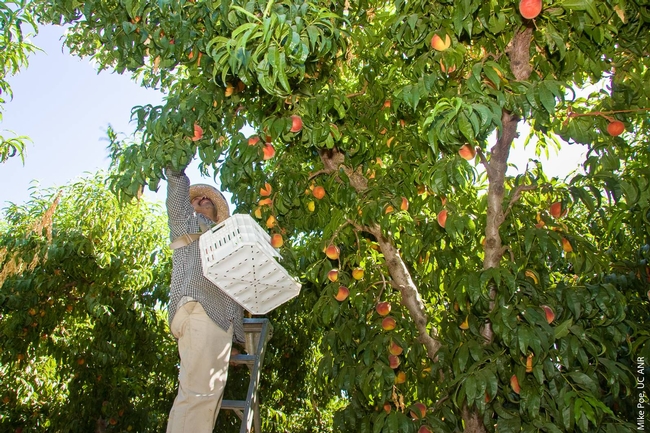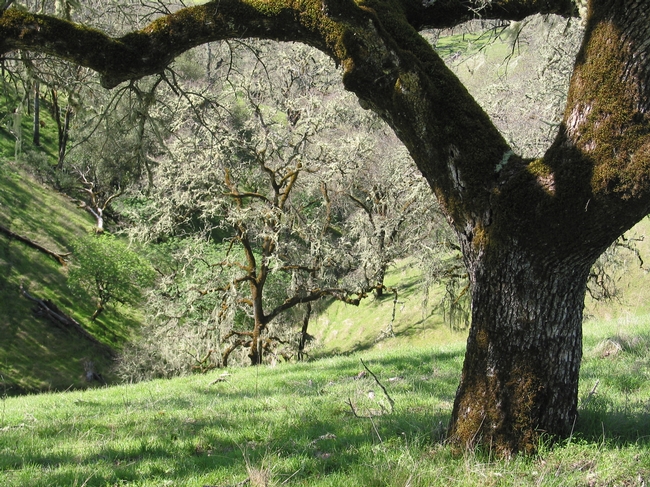
Posts Tagged: Landscapes
To protect California ecosystem services, they must be valued
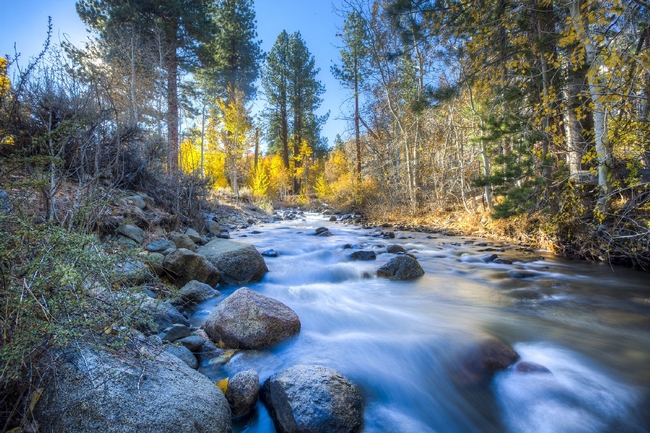
In addition to direct economic outputs, working landscapes – farms, rangelands, forests and fisheries, to name a few – sequester carbon, capture water, support wildlife, offer picturesque views and make space for hiking, skiing, boating and other recreational activities.
“We need to put a value to ecosystem services, from an economic standpoint, that incentivizes people who own and manage these landscapes so they can continue to manage them for everyone's benefit,” said Stephanie Larson, UC Cooperative Extension rangeland advisor in Sonoma County.
When ecosystem services have been monetized, proper compensation can be calculated, ensuring benefits like clean water, fresh air and a livable climate are protected for future generations.
In November, UC Agriculture and Natural Resources released a report at the California Economic Summit in Fresno on the value of California's working landscapes. The report determined the state's working landscapes generate $333 billion in annual sales and 1.5 million jobs. That number does not include ecosystem services.
“The value of ecosystem services is probably higher than the $333 billion direct economic contribution of working landscapes outlined in the report,” said Glenda Humiston, University of California vice president for agriculture and natural resources. Humiston is chair of the economic summit's working landscape task force. “The problem is, when we don't have that quantified, it's hard to make investments to make sure those ecosystem services are maintained.”
Humiston said that, in time, systems can be developed for the public to support the ecosystem services they enjoy.
“You might have a small surcharge on binoculars,” she said. “That money could be used to protect bird habitat so birders can go somewhere to see birds. Water districts might assess a surcharge on your water bill to pay for the forested watersheds where they are getting your water. There are many different mechanisms to do this. We're trying to figure out what would be the best mechanism.”
During the summit, a team of researchers, policymakers and industry professionals launched a new phase of work to calculate with scientific accuracy the value of ecosystem services. Larson is a member of the leadership team, along with executive director of the Central Valley Partnership Dan O'Connell and Sequoia Riverlands Trust director of pubic planning and policy Adam Livingston.
The team is working with partners to secure funding and technical support to integrate data sets already available from the Council of Governments' Rural-Urban Connections Strategy into an open source, statewide system for mapping ecosystem services.
Once the tool is established, the team will be ready to pilot test it in four areas of California that provide ecosystem services.
“I love this concept,” said Kenny Spain, economic development specialist with the Headwaters Fund in Humboldt County and a member of the task force. “It's a valuable tool.”
Learn more:
View a 4-minute video of UC ANR vice president Glenda Humiston announcing the release of the report, California's Working Landscape: A Key Contributor to the State's Economic Vitality, at the 2019 California Economic Summit.
View California Governor Gavin Newsom's keynote address at the 2019 California Economic Summit:
California’s working landscape generates $333 billion in sales, 1.5 million jobs
California's working landscape and the industries associated with agriculture and natural resources contribute significantly to the state's economy, according to a new study by the California Community Colleges Centers of Excellence for Labor Market Research, California Economic Summit and the University of California's Division of Agriculture and Natural Resources.
“When people think of California's economy, they think of entertainment, information technology and other industries. They may not think of working landscape,” said Glenda Humiston, University of California vice president, agriculture and natural resources. “People may be surprised to learn that California's working landscape accounts for 6.4% of the state's economy, supports more than 1.5 million jobs and generates $333 billion in sales.”
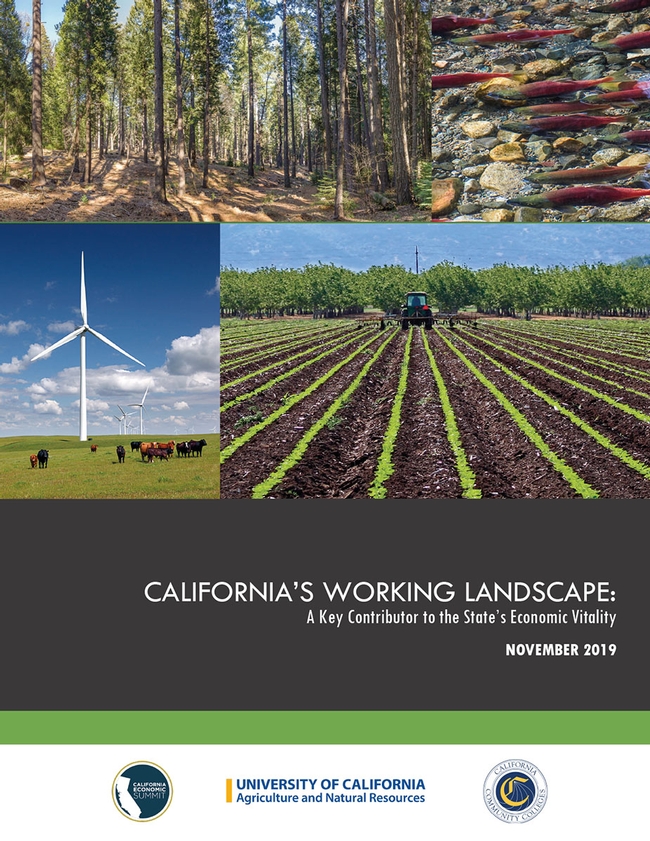
To measure the economic impact of the working landscape, researchers from the Centers of Excellence, California Economic Summit and UC Agriculture and Natural Resources analyzed federal data associated with employment, earnings and sales income of the nine segments that are essential to the working landscape: agricultural distribution, agricultural production, agricultural processing, agricultural support, fishing, forestry, mining, outdoor recreation and renewable energy.
Their analysis of 2018 data from the North American Industry Classification System showed the value of the working landscape in California comes in ahead of the health care, real estate, retail and construction industries. The top five economic drivers were government (21.9%), manufacturing (10.2%), information (9.3%), professional, scientific and technical services (7.5%), and finance and insurance (6.4%).
The researchers found the nearly 70,000 businesses associated with the working landscape paid $85 billion to workers in 2018 and generated $333 billion in sales income. In terms of job numbers, earnings, sales income and number of establishments, four segments dominate: agricultural distribution, agricultural production, agricultural processing and agricultural support.
Agricultural production provides the greatest number of jobs, more than 325,000, and generates the second highest sales income, $61 billion in 2018. Although agriculture accounts for 79% of working landscape sales income, it is important to note that other working landscape segments are still sizeable when compared to the rest of the nation.
In addition to evaluating the contribution of the industries to the state's economy, the researchers measured the importance and impact of the nine working landscape segments by region. For example, some segments, although relatively small in terms of employment or sales income, are cornerstones of local economies and play a critical role in the livelihoods of communities.
The Los Angeles/Orange County region, the San Francisco Bay Area, and San Joaquin Valley have the greatest concentration of jobs for agricultural distribution, agricultural processing, agricultural support, mining and renewable energy. The San Joaquin Valley leads in agricultural production, followed by the Central Coast. Los Angeles/Orange County has the most forestry, fishing and outdoor recreation jobs.
This report does not include economic values for ecosystem services provided by California's working landscape such as clean water, nutritious food and a livable climate, or intangible goods that contribute to human well-being, such as recreation, aesthetic inspiration and cultural
To read the report “California's Working Landscape: A Key Contributor to the State's Economic Vitality,” visit http://ucanr.edu/WorkingLandscape. A one-page executive summary is available at http://bit.ly/2WTA7Vz.
Headwaters
I have the privilege of engaging California's communities with the aspiration of safeguarding the sustenance and well-being that its oak-woodland watersheds and the people that are a part of them provide. This millennia-long integrated relationship of humans and land has parallel histories in other Mediterranean parts of the world. The following blog is the first of occasional installments about working Mediterranean landscapes in California and around the globe. Combined they will explore the concepts of watershed functions, working landscapes and Mediterranean climate, vegetation and management. Join me in experiencing these settings, growing our appreciation for the integrated nature of these landscapes and people, and gaining understanding and tools for our tenure as stewards. - David Lewis, director, UC Cooperative Extension, Marin County
I am standing where stream flow begins, in a nameless tributary of the Russian River to the east of Hopland, Calif. This particular spot and location has been a grazing livestock ranch, primarily sheep, going back more than 100 years (learn more). This is one of thousands of spots in a watershed where water comes to the surface, joins in a channel and starts its path downstream. Many of us have stood at a confluence of two rivers or an estuary where a watershed's outfall meets an ocean. These locations are the stream's or river's end, their terminus. Where I am standing, is the headwaters of a stream system, where water is initially released and visible as a thin, shallow bouncing band.
Watersheds collect, store, and transport water. The transport function is performed by streams and rivers. These are dynamic, pervious channel networks each with a beginning and an end. At any part of the network, the channel is that lowest point in the landscape, stretching from one stream bank to the other, and generally widening in the downstream direction, until the stream mouth empties into another water body.
At the other end of a network is the channel head, where the channel begins. This is where I am standing. Channel heads are found in small, intimate folds in the landscape. These depressions are referred to by many names — draws, bowls, hollows — the place in hills where the slopes become shallow and coalesce.
Like an amphitheater, the surrounding hillslopes rise around me. Reaching out at shoulder height, I can almost touch these slopes. The mixed oak woodland and interspersed grasslands are in attendance across these slopes. Ghost pines, live oaks, black oaks and madrones, among other trees, make their stand interspersed with annual and perennial grasses blanketing the ground. This mosaic of vegetation is hosted and sustained by the complex mix of marine sediments that have been pushed up, forming these hills, and erosion carving the stream channel. Below the surface are soils one to three feet deep that have developed from the underlying geology.
It's March 3, 2019, and on the cusp of spring. Between the light breezes, the stream water sings its way downstream. I think back to the intense storms that moved across this part of California the week before and the resulting floods in the lower portion of the Russian River. Those and earlier winter storms soaked into the soil until the soil reached its capacity to hold water. Once the soils were primed, water was released to the channel network. That water is still being released now, days later, and will be for several more months into May or even June. Rainfall for this area and most of California has been substantial, matching amounts not seen since 1983, and definitively ending the nearly five-year drought. This contrast in extremes is the norm for California, meaning the next drought or next flood is only a year away.
Downstream the Russian River is perennial, flowing year-round. But here at the channel head, flow is intermittent on an annual cycle. Rains begin in the fall, with headwater surface flows starting in late fall or early winter, once soils are saturated. This wetting up process reverses in the spring, until the channel head is dry.
At some point this year flow in the headwaters will stop. Saturated soils releasing water laterally below the ground surface, will gradually release less and less water to the channel. Trees and grasses will demand more and more water as they leaf out and grow. As soils pores empty of free water, the remaining moisture is held more tightly to soil particles and plant root surfaces through a physical tension. Eventually the channel head will run dry.
While you may not have the opportunity to visit a channel head and experience the place where stream flow starts and stops each year, you are often closer to one than you think. Driving a rural road or hiking in a favorite park or open space will invariably find you crossing one of these unnamed headwater streams. As you do, give a look upstream, from where the water going past you has come. Up the channel into the bowl is one of the channel heads and headwaters for the watershed you are in.
I don't know when I will get to this channel head again. However, this place where surface flow is initiated will be close in my mind, particularly, as I visit the confluences and estuary of the Russian River, during the wet and dry periods and high and low rainfall years to come.
To learn more about these specific watersheds and research conducted in them this article is suggested. If interested in learning how stream flow is generated in California oak woodland watersheds you may want to read this article.
Can you have it all? Probably not but you can change your attitude.
In what has been dubbed “dandelion-gate,” members of the Washington State legislature spent 20 minutes complaining about weeds on the capital's lawn “In all the years I've been here I've never seen so many dandelions all over,” Sen. Mike Padden (R) said. “Is it...
Just started new tests of contact herbicides
There has been more than the usual number of questions about what I am calling "bio-based" herbicides recently. Arguably, this is coming from news that some school districts and cities specifically calling out the use of glyphosate on the properties they manage. Landscaping...

